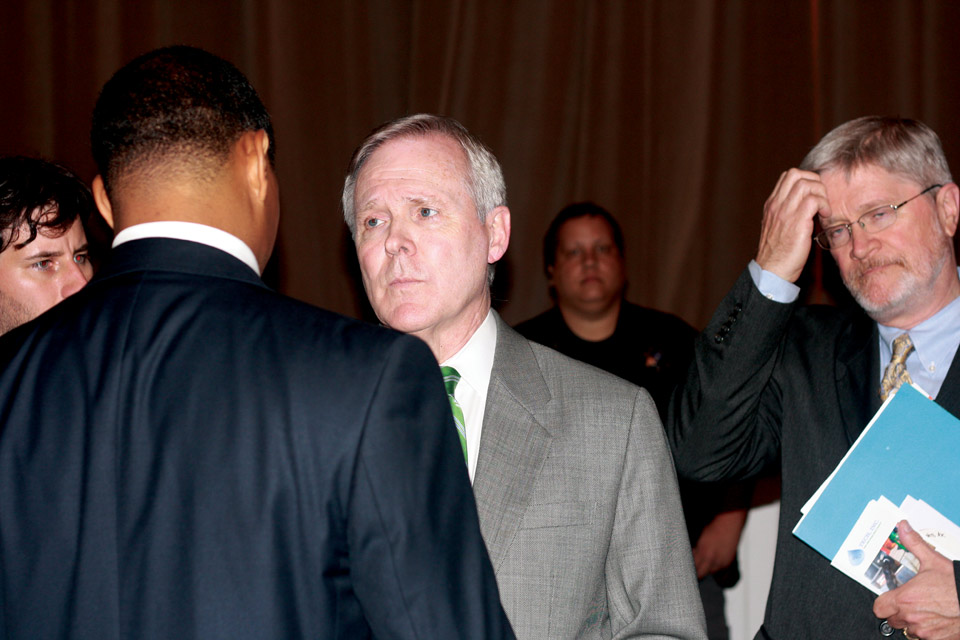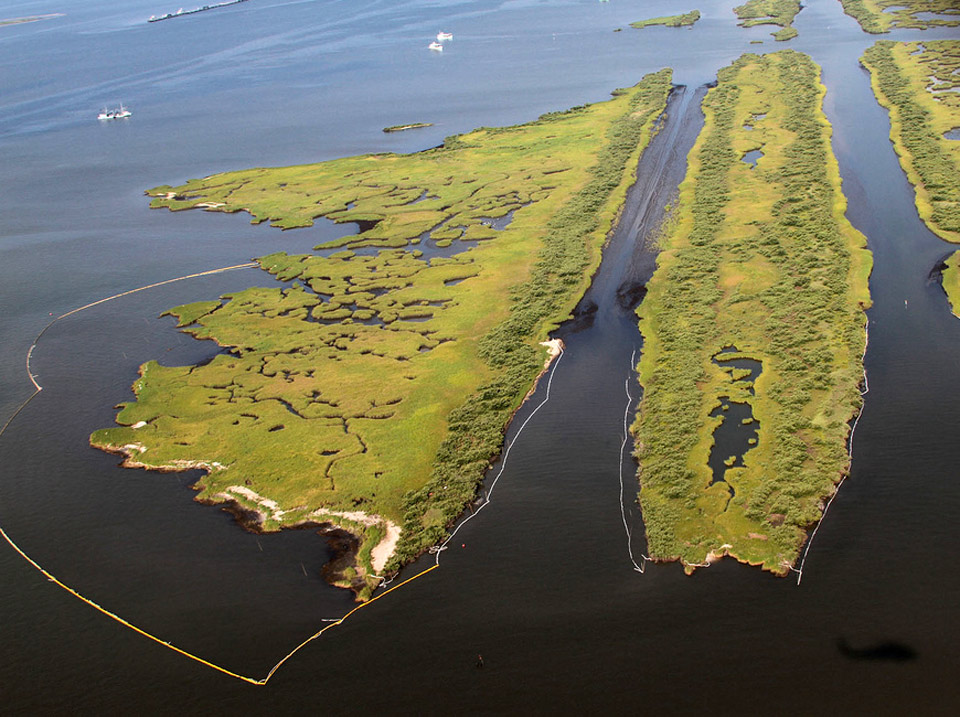@font-face {“Cambria”; }@font-face {“Swift-Light”; }p.MsoNormal, li.MsoNormal, div.MsoNormal { margin: 0in 0in 10pt; font-size: 12pt;”Times New Roman”; }p.BodyCopy-DropCap, li.BodyCopy-DropCap, div.BodyCopy-DropCap { margin: 0in 0in 0.0001pt; line-height: 11pt; font-size: 8.5pt; color: black; }div.Section1 { page: Section1; }
As the federal government promotes initiatives to ensure long-term recovery for the oil-spill-beleaguered Gulf Coast region, officials are attempting to court marginalized community groups whose members say their suggestions have been disregarded or they have been left out of discussions entirely. But the reaction has been skeptical, with residents saying they have been deceived by low-ball official assessments of environmental and health threats.
Residents say they are increasingly anxious about the economic and environmental viability of life along the shoreline. As many as one-quarter of the region’s residents say they are thinking of moving away.
Months after the April 20 Deepwater Horizon oil-well platform blow-out — which spewed nearly 5 million barrels of toxic sludge into the Gulf of Mexico and killed 11 workers — the government is vowing long-term commitment to recovery from the nation’s largest-ever oil spill. The Obama administration has launched a $20 million, multiyear health impact study and awarded $31 million in grants for coastal restoration and economic development.
The effort crescendoed in late September as Navy Secretary Ray Mabus, who is also the Obama administration’s point man for the recovery effort, released his roadmap for rebuilding the region. The plan recommended BP pay civil penalties into a fund for the region and that the federal government dedicate money to strengthen the economy and restore the environment. “The plan is the result of listening to the people of the Gulf Coast. It balances the needs of the people, the environment and the economic livelihood of the region,” Mabus said.
But community leaders, such as Diane Huhn, environmental outreach volunteer coordinator for Bayou Grace Community Services, believe that important community suggestions were left out of Mabus’ plan. “The big key is the citizen advisory committee,” Huhn said. She is worried the recovery funds, administered by politicians with ties to the oil and gas industries, will be too slow to save the ravaged coastline.
“These folks representing the community and the tribes feel they are not being given a seat at the table,” said Denise Byrne, acting director of Friends of New Orleans, a nonprofit organization that advocates for the region’s interest. “These are the people that are living with the consequences.”
Many local organizers, who have long advocated for coastal restoration projects to combat decades of erosion and environmental damage from oil drilling, see these funds as crucial to the cause. “We wanted to see true stakeholder engagement,” Huhn said, “I am concerned about the speed at which we move. We are losing land at 25 square miles per year, a football field of land every 30 to 35 minutes.”
Some local residents like John Tesvich, chairman of the Louisiana Oyster Task Force, don’t share Huhn’s sense of urgency. “I don’t see any problems yet. It is still early in the process. There were probably some mis-steps early, but that can be expected as there was no dress rehearsal for that.”
When asked if he trusted the Obama administration’s long term commitment, Tesvich said: “We have to. That is what they are saying.”
DECADE’S SECOND EXODUS
“People are worried about the changes to their way of life,” said David Abramson, director of research at Columbia University’s National Center for Disaster Preparedness.
One-quarter of Gulf Coast residents say they believe they will have to move, according to a study Abramson’s center published over the summer. The figure is striking, given that most Gulf Coast residents tend to have genealogies tracing back generations. “In New Orleans, for example, 85 percent of people that live in the city were born there,” Abramson said.
Lance Nacio is a leader of the White Boot Brigade, a seven-year-old, nonprofit organization composed mainly of shrimpers. He did not fish all summer.
Instead, he worked for BP, the oil-industry titan that operated the Deepwater Horizon platform, alongside 23 other shrimp boats in the Vessels of Opportunity program, an initiative meant to put coast residents to work cleaning up the spill, laying booms and gathering 10 million gallons of oil from Gulf waters before burning the collected muck. (Nacio said the boom and burn programs were “the most effective part of the cleanup effort.”)
Now, as BP is talking with Nacio about ending his service, he is worried about the future of his business.
“The fisherman, all they know how to do is fish,” he said. “Our culture, heritage and livelihood are at stake.”
Already, 8 percent of coast residents have reported losing their jobs, according to the Columbia study. The number is expected to increase as BP scales back cleanup crews.
Another study by Louisiana State University found that underestimates by federal officials and by BP of the spill’s impact have eroded public trust in both (BP’s initial leakage estimates had to be raised to 60,000 barrels a day from 1,000).
Residents say the distrust is a result of draconian measures BP took to prevent negative press. Reporters were barred from oiled coastlands, marshes or waters without an escort. And even with an escort, journalists were restricted to specific areas. Photography was banned on public beaches and cleanup workers were made to sign pledges to avoid speaking to anyone about the spill.
Over the summer, both BP officials and federal organizations coordinating the response said that instances of limiting news media access were few and far between. BP reportedly began issuing 40,000 cards to its cleanup workers saying they should cooperate with news media.
But denial of access to many oil-affected areas continued, and residents complained of psychological damage resulting from BP’s restrictions.
“The media blackout is real within the community,” said Patty Whitney, a community organizer with the Bayou Interfaith Shared Community Organizing, which represents 30,000 families in Terrebonne Parish, Louisiana.
Residents heard reports of workers ending up in the hospital with severe symptoms such as bleeding ears, and they did not know what to believe, Whitney said. “There is a feeling that if you have to hide it, then it must be bad.”
In August, while preparing his report, Mabus toured the Gulf region to assure the public of the government’s commitment to helping the area rebound.
Mabus’ visit came amid a flurry of sunny news reports that only 26 percent of the leaked oil remained in Gulf waters. But the handful of community discussions he held were reminiscent of heated “ObamaCare” town hall debates that saw Democratic Congress members shouted down.
During a town hall meeting in Plaquemines Parish, Louisiana, a fishing area heavily affected by the spill, residents tore into Mabus and representatives from BP, the EPA, the National Oceanic and Atmospheric Administration and anyone else involved in the oil spill response.
“I know everybody is concerned about today,” Mabus told the crowd, “ but we also have to worry about the long term.”
That didn’t sit well with Mac Mackenzie, an organizer with the watchdog group Defenders of the Coast. “I appreciate that you want to take care of us in the long term,” he said. “But people don’t feel taken care of today.”
When asked privately how the federal government planned to handle the anger and frustration of coastal communities suspicious of claims that the cleanup complete while pushing for long-term recovery, Mabus said, “I think it is important that there is no gap between the short-term response and long-term recovery.”
BOTTOM-UP LEADERSHIP
In September, the National Institutes of Health launched a multiyear, $20 million study on the health impacts of the oil spill
“Community involvement and participation is critical to the success of this study,” said Linda Birnbaum, director of the National Institute of Environmental Health Sciences.
Three weeks earlier, U.S. Commerce Secretary Gary Locke traveled to the coast to announce at an economic roundtable in Metairie, Louisiana, that the government was awarding $30 million in restoration funding to the state.
But the money is not enough for community groups that seek to be involved in the process. In mid-September, Friends of New Orleans, a nonprofit organization advocating for the region’s interests, gathered a group of writers, business owners, environmental organizations, fishermen and others to testify before Congress that more engagement was needed.
“It is a matter of what is considered engagement,” said LaTosha Brown, executive director of the Gulf Coast Fund. She said that thus far, the relationship between the federal government and community organizations in the region has been similar to that of a boss dictating to an employee.
“There has been more engagement with high-level officials,” Brown said, “But the actual framing and leadership needs to be driven from the bottom up.”
The Gulf Coast Fund, created after Hurricane Katrina in 2005, locates resources and funding for 175 community groups serving hurricane refugees spread out from Texas to Florida. Many of those residents would return to the Gulf Coast if the environment were returned to its previous state.
“We don’t want charity,” Byrne said, “We want the government to preserve this incredible natural resource.”

A version of this article was published in the fall 2010 edition of the San Francisco Public Press newspaper. Read select stories online, or buy a copy.










